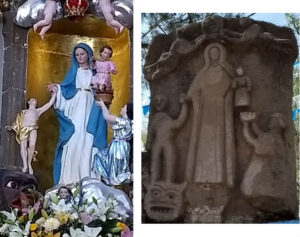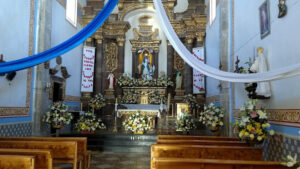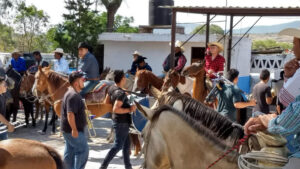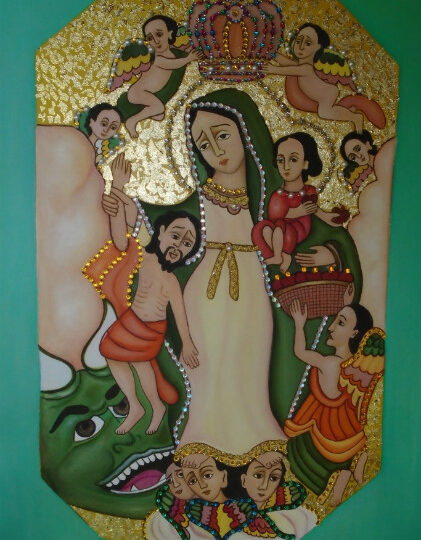Mary, in art, is typically shown as being contemplative, reflective, even sad, but, for me, her best image is Mary of the Light, or Maria de la Luz. There she is aggressive and assertive. She is widely celebrated as such this time of year.
Back in 1722 Sicily [Oh no, I’ve turned into Ma from Golden Girls!] a nun had a painter depict an image of Mary. In many ways this painting is very typical of Colonial era art featuring Mary: As Queen of Heaven, Mary has a crown; baby Jesus in one of her hands, giving away hearts on fire to show his eternal love.
What makes the painting very unique is what Mary has in her other hand. With that hand she is lifting up a man, preventing him from falling into the jaws of Leviathan, an sea monster from the Old Testament who swallows men’s souls into the Sea of Chaos. Thus, with the fierceness of a lioness, Mary is saving one of her cubs from a chaotic future.
Ten years after its creation the painting was taken, to nearby Leon by the Jesuits. As you fly in or out of Leon airport, notice the large cathedral in middle of town. That church is called Maria de Luz, because it houses the original painting.
 Then the Jesuits made copies of the painting and with them spread veneration throughout Mexico as the image became wildly popular. When at the altar of the Parroquia, look up and to your left to see murals depicting these events.
Then the Jesuits made copies of the painting and with them spread veneration throughout Mexico as the image became wildly popular. When at the altar of the Parroquia, look up and to your left to see murals depicting these events.
Every church in town will have at least one Maria de Luz. So too, most of us have at least one neighbor with the name Maria de Luz, often shorten to Malu. In my case, I could have sworn my neighbor, Malu’s name was Shamu. I spent over a year calling her as if she were a killer whale.
When this image of Mary grew in popularity, the Pope decided that it wasn’t proper to have Mary next to a pagan sea monster. So he told folks to either black out the sea monster (so Mary was lifting the man up from the darkness of Purgatory) or place Leviathan in the fires of hell. (Indigenous artists, to poke fun at the Spanish, always included clergy in their depictions of hellfire.)
The celebrations for Maria de la Luz begin just after the Valle de Maiz festival for the cross at the end of May. The neighborhood behind the mall is named in her honor and has a namesake church (currently being expanded.) The week long celebrations include dances, rides, food and music in addition to devotional rosaries and masses.
The stars on long poles you see in various processions are in honor of Maria de la Luz. The tradition came from the town of Salvatierra in the 1920’s when recently laid off factory workers found jobs at what are today the high end art galleries. Maria de la Luz was an important image to those former factory workers. Maria de la Luz (Mary of the Light) is also the patroness of electricians.
 There is also the street named Calzada de la Luz in her honor by that former factory. If you really want to celebrate her feast day with a bang, take the city bus to Santa Marias. The bus line dead ends at the community called Puerto de Nieto, home to the oldest church named for Mary of the Light in our area.
There is also the street named Calzada de la Luz in her honor by that former factory. If you really want to celebrate her feast day with a bang, take the city bus to Santa Marias. The bus line dead ends at the community called Puerto de Nieto, home to the oldest church named for Mary of the Light in our area.
Here, in Puerto de Nieto, following a mass featuring cowboys, who remove their hats as they enter the service on horseback and are blessed by the priest, some real fun starts. Food, concerts, boxing matches and a wide variety of entertainment mark the community’s biggest festival of the year.
In addition to Mary’s aggression in the image of Mary of the Light, I enjoy how the i mage of the sea monster has changed in this landlocked area of Mexico; how did the indigenous picture a sea monster?
mage of the sea monster has changed in this landlocked area of Mexico; how did the indigenous picture a sea monster?
At the end of all my tours I ask folks to identify a Chichimeca interpretation of the Virgin in a painting I received as a birthday gift last year. If they do so correctly, then not only do they not have to tip me, but I give them the image of my birthday cake’s version of Mary of the Light. In both the cake and painting the sea monster appears like a green, giddy bull.
As you go around town notice that the sea monster’s face has as many variations, from gleeful to grim, as does Satan’s when he finds himself under St. Michael’s boot.



